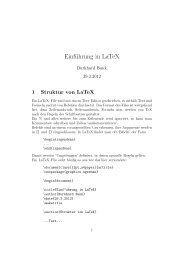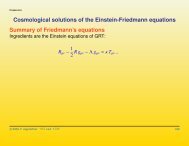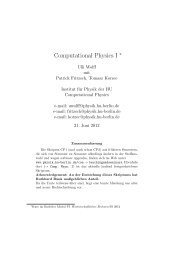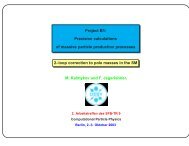Preprint[pdf] - HU Berlin
Preprint[pdf] - HU Berlin
Preprint[pdf] - HU Berlin
Create successful ePaper yourself
Turn your PDF publications into a flip-book with our unique Google optimized e-Paper software.
i e 2<br />
�<br />
d 4 x e iqx 〈0|Tj µ em (x)jν em (0)|0〉 = −(q2 g µν − q µ q ν )Π ′ γ (q2 ) , (64)<br />
which is purely transversal by virtue of electromagnetic current conservation ∂µj µ em(x) = 0.<br />
In terms of the fine structure constant α = e2<br />
4π Eq. (63) reads<br />
α(q 2 α<br />
) =<br />
1 − ∆α(q2 ; ∆α(q<br />
)<br />
2 ) = −Re � Π ′ γ(q 2 ) − Π ′ γ(0) � . (65)<br />
The various contributions to the shift in the fine structure constant come from the leptons (lep = e, µ and<br />
τ), the 5 light quarks (u, b, s, c, and b) and/or the corresponding hadrons (had). The top quark is too heavy<br />
to give a relevant contribution. The hadronic contributions will be considered later.<br />
The renormalized photon self–energy is an analytic function and satisfies the dispersion relation (DR)<br />
− Π′ γ ren(k 2 )<br />
k 2<br />
=<br />
�∞<br />
0<br />
ds<br />
s<br />
1<br />
π Im Π′ γ(s)<br />
1<br />
k2 . (66)<br />
− s<br />
Note that the only k dependence under the convolution integral shows up in the last factor. Thus, in a<br />
generic VP contribution<br />
µ<br />
γ<br />
γ<br />
X<br />
γ<br />
where the “blob” is the full photon propagator, including all kinds of contributions as predicted by the SM<br />
or beyond, the free photon propagator in the 1–loop vertex graph in the next higher order is replaced by<br />
−igµν/k 2 → −igµν/(k 2 − s) ,<br />
which is the exchange of a photon of mass square s. This result then has to be convoluted with the imaginary<br />
part of the photon vacuum polarization. The calculation of the contribution from the massive photon<br />
proceeds exactly as in the massless case. Again FM(0) most simply may be calculated using the projection<br />
method which allows one to work at q 2 = 0. The result is [153,154]<br />
(2) heavy γ<br />
a µ ≡ α<br />
π K(2) µ (s) = α<br />
π<br />
�1<br />
0<br />
dx<br />
x2 (1 − x)<br />
x2 + (s/m2 , (67)<br />
µ)(1 − x)<br />
which is the leading order contribution to aµ from an exchange of a photon with square mass s. For s = 0<br />
we get the known Schwinger result. Utilizing this result and Eq. (66), the contribution from the “blob” to<br />
g − 2 reads<br />
a (X)<br />
µ = α<br />
π2 �∞<br />
0<br />
ds<br />
s Im Π′ (X)<br />
γ (s) K (2)<br />
µ (s) . (68)<br />
If we exchange integrations and evaluating the DR we arrive at [19]<br />
a (X)<br />
µ = α<br />
�1<br />
π<br />
0<br />
= α<br />
π<br />
�<br />
0<br />
1<br />
dx (1 − x)<br />
dx (1 − x)<br />
�∞<br />
0<br />
ds<br />
s<br />
1<br />
π Im Π′ (X) x<br />
γ (s)<br />
2<br />
x2 + (s/m2 µ)(1 − x)<br />
�<br />
−Π ′ �<br />
(X)<br />
γ (sx) , with sx = − x2<br />
1 − x m2 µ . (69)<br />
28


![Preprint[pdf] - HU Berlin](https://img.yumpu.com/3833433/28/500x640/preprintpdf-hu-berlin.jpg)




